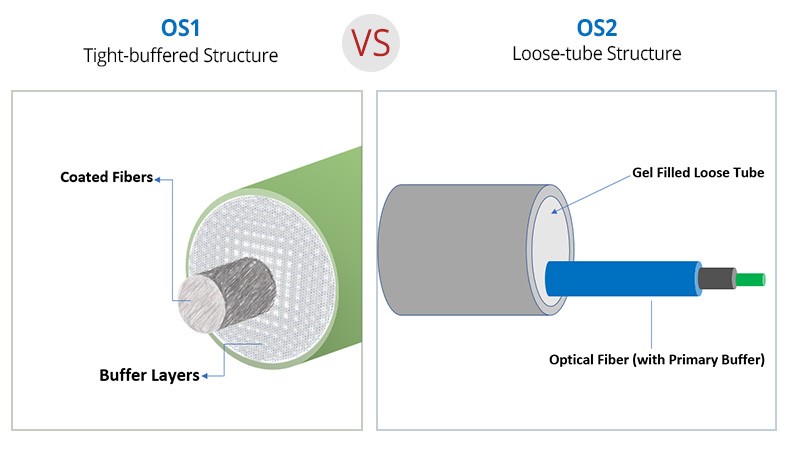What is OS1 Fiber?
OS1 Fiber refers to a type of optical fiber cable specifically designed for outdoor use. It is characterized by its single-mode fiber construction, which means it has a small core size (typically around 9 microns) that allows light to propagate through the fiber with minimal dispersion.
OS1 Fiber is optimized for long-distance communication and high-speed data transmission. It is commonly used in telecommunications networks, internet backbone infrastructure, and other applications where high bandwidth and reliability are essential, particularly over longer distances.
The "OS1" designation typically refers to the cable's specifications and performance standards defined by the Telecommunications Industry Association (TIA). These standards ensure interoperability and compatibility between different network components and manufacturers.
What is OS2 Fiber?
OS2 Fiber is another type of optical fiber cable designed for outdoor use, similar to OS1 Fiber. However, OS2 Fiber is optimized for longer distances and higher data rates compared to OS1 Fiber.
The key difference between OS1 and OS2 Fiber lies in their core sizes and attenuation characteristics. OS2 Fiber also uses single-mode fiber, but it typically has a smaller core size (around 9 microns) and lower attenuation, allowing for even greater transmission distances and higher data rates.
OS2 Fiber is commonly used in long-haul telecommunications networks, submarine cables, and other applications requiring high bandwidth and reliability over extended distances. It is designed to meet stringent performance standards set by organizations such as the Telecommunications Industry Association (TIA) to ensure compatibility and interoperability across different network components and manufacturers.
What is OS1 and OS2 single-mode fiber?
Both OS1 and OS2 fibers are single-mode fibers regulated by ITU-T standards (i.e. ITU-T Recommendations, which describe the geometric and transmission characteristics of single-mode and multimode fibers). In ITU-T standards, OS1 single-mode fiber is a traditional single-mode fiber that complies with the G.652.A and G.652B (conventional) fiber standards. OS2 single mode fiber is a single mode fiber that conforms to the G.652C and G.652D fiber standards, also known as low water peak fiber or zero water peak fiber, which is often used in CWDM networks. In addition, a bend-insensitive single-mode fiber with excellent bending resistance is regulated in the latest ITU-T fiber standard G.657A1, and some fiber suppliers on the market can provide OS2 single-mode fiber that meets this standard.
What is the difference between OS1 and OS2 single-mode fiber?
Standards: OS1 single-mode fiber generally complies with ITU-T G.652 standards, including ITU-T G.652.A and ITU-T G.652B standards (conventional), ITU-T G.652C and G.652D standards (low water peak). OS2 single-mode fibers usually meet the fiber standard G.652C or G.652D, also known as single-mode zero water peak fiber or single-mode low water peak fiber, these low water peak fibers are commonly used in CWDM (coarse wavelength division multiplexing) applications. In addition, the new cabling standard G.657.A1 was released for bend-insensitive single-mode fiber jumpers to optimize the cost performance of fiber products, and OS2 single-mode fiber that meets this standard is also available on the market today.
Cable construction: OS1 single-mode fiber is usually a tight tube construction, designed for indoor applications, it is usually a protective jacket outside, wrapped in a flexible fiber polymer (such as aramidon yarn). The OS1 single mode fiber core and cladding are made of glass, which is non-bendable and fragile, and the coating layer provides protection and extends the service life of the fiber. OS2 single-mode fibers are typically designed with loose bushing, which is more suitable for outdoor applications and requires a more robust cable construction when deployed in some extreme environments. The OS2 single-mode fiber is helically placed in a semi-rigid tube, so that the OS2 can be extended without bending the internal fiber, lest the fiber be damaged under great tension.

Attenuation value: The attenuation value of OS1 single-mode fiber is greater than that of OS2 single-mode fiber. In general, OS1 single-mode fibers have a maximum attenuation value of 1.0db/km in the 1310nm and 1550nm bands, while OS2 has a maximum attenuation value of 0.4db/km.
Transmission distance: The transmission distance of OS1 and OS2 single-mode fibers is different. The maximum transmission distance of OS1 single-mode fiber is 10km, while the maximum transmission distance of OS2 single-mode fiber can reach 200km. In addition, both OS1 and OS2 single-mode fibers can achieve 1G to 10G transmission rates over different transmission distances, but OS2 single-mode fibers can also be used for 40G/100G Ethernet transmission.
Application scenario: OS1 is commonly used for short-range single-mode fiber applications such as data centers, local area networks (Lans), and internal enterprise applications. OS2 is suitable for longer range single-mode fiber transmission and is commonly used in applications such as wide area networks (WAN), long-distance communications and long-distance network connections.
In general, OS1 and OS2 single-mode fibers have their own advantages and application scenarios. The selection of the appropriate fiber type needs to be determined according to the specific application requirements and environmental conditions. In practical applications, it is recommended to consult our professionals to ensure that the most suitable fiber optic solution is selected.
03-21
202502-12
202509-12
202409-05
202408-16
202408-07
202408-06
202408-02
202407-30
202407-29
2024
